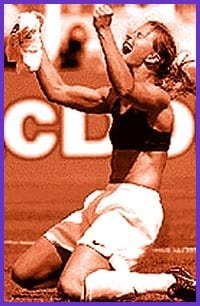This summer I participated in a soccer tournament in San Francisco called the Festival Of Babes, or FOB. And in doing so I freed my mind from that unfortunate stereotype around lesbians and sports.
I’m not the only one. The lines between “female athlete” and “lesbian jock” are beginning to obscure. There used to be a rift between the two that can best be defined as bravado.
Lesbians are all about bravado. A lesbian jock will spend all morning pumping up her biceps at the gym. From there she will go to her basketball game and get even more time in on her biceps. Then that night she will head out for a beer wearing a sleeveless top to make sure everyone can see her biceps.
Now straight girls are turning up with some notably developed biceps. As mainstream feminine ideals slacken and the female athlete is legitimized as “sexy,” lesbians are being given the moral go ahead to be honest about the fact that often, what keeps them engaged in athletic endeavours is the outright sexiness of it all.
In the way that professional wrestling isn’t really wrestling, the Festival Of Babes tournament isn’t really soccer. FOB protocol can be summed up as, “It’s okay to tongue.”
At FOB, a team is not allowed to lead a game by more than five points and if it does, each member must remove an article of clothing. For each point increase in the margin of the lead, another item of clothing must come off. One team ended up playing nearly naked after their opponents stopped defending their goal and just let them score. This is a celebration of the sexuality of sport that lesbians have sometimes made efforts to distance themselves from.
In the past, the sporting environment has provided lesbians with a place to expand their identities, sexual and otherwise. But that has led to the creation of stereotypes. You know. She is perfectly embodied in the woman who taught girls physical education in your high school, wearing her running shoes and track pants everywhere. In the past, to be a sports chick was to be far from glamour (though there was a moment when all us girls ran out to get Dorothy Hamill haircuts).
The new attitude toward women and sports has managed to break this stereotype. An arena full of athletes whose concentration is fully aligned with their bodies is a sensual place. Elements of this persona are finding their way into popular culture with the rise of women’s professional sports and a certain sporty Spice Girl, now reborn as Mel C.
The attention surrounding the US women’s soccer team has yet to abate since the squad won the World Cup championship last July. The championship match was the most-watched soccer game ever on US network television. David Letterman snapped the team up for an appearance almost immediately. Sports Illustrated has gone nuts over them. Nike can’t formulate advertising concepts fast enough.
I am wary of giving the media too much credit for championing female athletics. An indispensable tool for setting and reinforcing ideals, the media is also guilty of hyping a particular aesthetic in Team USA. The US women’s Olympic basketball team became the WNBA after it took the gold medal in the 1996 Olympics. What did we hear of this? Not much. But then those girls don’t look much like the milk-fed “soccer babes,” as Letterman calls them.
Think of the photograph that was taken when the US women’s soccer team won the World Cup and was plastered everywhere in the weeks afterward. Brandi Chastain, the buffed blonde who scored the winning goal, on her knees, in her shorts and sports bra, holding her jersey in her hand because she tore it off in celebration.
The sexiness of this photo can be lost on nobody, least of all lesbians. Sports Illustrated knows women’s sports has erotic overtones and so does TSN.
Traditionally, when the media blends sex and sport, they end up looking like sexist pigs or homosexuals. But this relationship defines the lesbian conscience; any lesbian, sporty or otherwise, will read sexiness into a group of women engaged in sport. This is why my girlfriend, who considers the world of televised sports to be far beneath her, will happily watch if women are playing. “Those are girls?” she asks. “Yummy.”
Straight women are also looking at sport with different eyes. I was out for drinks with soccer teammates and ran into a straight-for-the-most-part co-worker. When I introduced everyone, she leaned into me and asked in a coy manner if she could play soccer with us sometime.
Is the influx of straight women in sport an enticing prospect that will make sports even sexier to lesbians? Or can we expect lesbian sports to push sport to even sexier ground, like the atmosphere of FOB? Is the increasing ambiguity of the sporty girl persona something lesbians are ready for?
I certainly hope so.

 Why you can trust Xtra
Why you can trust Xtra


